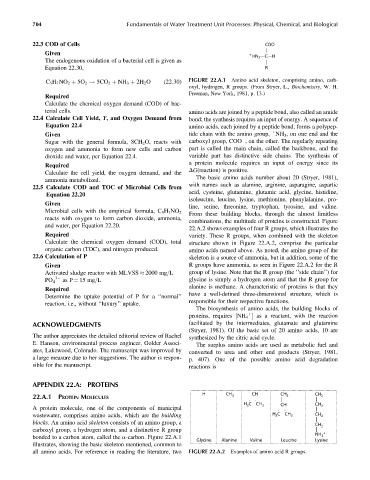Page 749 - Fundamentals of Water Treatment Unit Processes : Physical, Chemical, and Biological
P. 749
704 Fundamentals of Water Treatment Unit Processes: Physical, Chemical, and Biological
22.3 COD of Cells COO
Given j
þ HN 3 ---C---H
The endogenous oxidation of a bacterial cell is given as
j
Equation 22.30, R
C 5 H 7 NO 2 þ 5O 2 ! 5CO 2 þ NH 3 þ 2H 2 O (22:30) FIGURE 22.A.1 Amino acid skeleton, comprising amino, carb-
oxyl, hydrogen, R groups. (From Stryer, L., Biochemistry,W.H.
Freeman, New York, 1981, p. 13.)
Required
Calculate the chemical oxygen demand (COD) of bac-
terial cells. amino acids are joined by a peptide bond, also called an amide
22.4 Calculate Cell Yield, Y, and Oxygen Demand from bond; the synthesis requires an input of energy. A sequence of
Equation 22.4 amino acids, each joined by a peptide bond, forms a polypep-
Given tide chain with the amino group, NH 3 , on one end and the
þ
Sugar with the general formula, 8CH 2 O, reacts with carboxyl group, COO , on the other. The regularly repeating
oxygen and ammonia to form new cells and carbon part is called the main chain, called the backbone, and the
dioxide and water, per Equation 22.4. variable part has distinctive side chains. The synthesis of
a protein molecule requires an input of energy since its
Required
DG(reaction) is positive.
Calculate the cell yield, the oxygen demand, and the
The basic amino acids number about 20 (Stryer, 1981),
ammonia metabolized.
with names such as alamine, arginine, asparagine, aspartic
22.5 Calculate COD and TOC of Microbial Cells from
acid, cysteine, glutamine, glutamic acid, glycine, histidine,
Equation 22.20
isoleucine, leucine, lysine, methionine, phenylalanine, pro-
Given
line, serine, threonine, tryptophan, tyrosine, and valine.
Microbial cells with the empirical formula, C 5 H 7 NO 2
From these building blocks, through the almost limitless
reacts with oxygen to form carbon dioxide, ammonia,
combinations, the multitude of proteins is constructed. Figure
and water, per Equation 22.20.
22.A.2 shows examples of four R groups, which illustrates the
Required variety. These R groups, when combined with the skeleton
Calculate the chemical oxygen demand (COD), total structure shown in Figure 22.A.2, comprise the particular
organic carbon (TOC), and nitrogen produced. amino acids named above. As noted, the amino group of the
22.6 Calculation of P skeleton is a source of ammonia, but in addition, some of the
Given R groups have ammonia, as seen in Figure 22.A.2 for the R
Activated sludge reactor with MLVSS 2000 mg=L group of lysine. Note that the R group (the ‘‘side chain’’) for
3 as P ¼ 15 mg=L glycine is simply a hydrogen atom and that the R group for
PO 4
alanine is methane. A characteristic of proteins is that they
Required
have a well-defined three-dimensional structure, which is
Determine the uptake potential of P for a ‘‘normal’’
responsible for their respective functions.
reaction, i.e., without ‘‘luxury’’ uptake.
The biosynthesis of amino acids, the building blocks of
proteins, requires NH 4 as a reactant, with the reaction
þ
½
ACKNOWLEDGMENTS facilitated by the intermediates, glutamate and glutamine
(Stryer, 1981). Of the basic set of 20 amino acids, 10 are
The author appreciates the detailed editorial review of Rachel synthesized by the citric acid cycle.
E. Hanson, environmental process engineer, Golder Associ- The surplus amino acids are used as metabolic fuel and
ates, Lakewood, Colorado. The manuscript was improved by converted to urea and other end products (Stryer, 1981,
a large measure due to her suggestions. The author is respon- p. 407). One of the possible amino acid degradation
sible for the manuscript. reactions is
APPENDIX 22.A: PROTEINS
H CH 3 CH CH 2 CH
22.A.1 PROTEIN MOLECULES .. | | 2
H CCH 3 CH CH 2
3
A protein molecule, one of the components of municipal . . |
wastewater, comprises amino acids, which are the building H 3 CCH 3 CH 2
|
blocks. An amino acid skeleton consists of an amino group, a
CH 2
carboxyl group, a hydrogen atom, and a distinctive R group |
+
bonded to a carbon atom, called the a-carbon. Figure 22.A.1 NH 3
Glycine Alanine Valine Leucine Lysine
illustrates, showing the basic skeleton mentioned, common to
all amino acids. For reference in reading the literature, two FIGURE 22.A.2 Examples of amino acid R groups.

